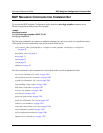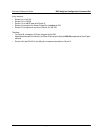
Command Reference Guide BGP Neighbor Configuration Command Set
61200510L1-35E Copyright © 2005 ADTRAN 1288
local-as <as-number>
Use the local-as command to specify an autonomous system (AS) number for the unit to use when commu-
nicating with this BGP neighbor. Use the no form of this command to return to default settings.
Syntax Description
<as-number>
Specifies the AS number to use when communicating with this neighbor. Must be
different than the AS number for this router and the peer router. Only valid for
eBGP connections. Range is 0 to 65,535.
Default Values
By default, no local AS number is defined. The router’s BGP AS number is used.
Applicable Platforms
This command applies to the NetVanta 300, 1000R, 2000, 3000, 4000, and 5000 and Total Access 900
Series units.
Command History
Release 9.3 Command was introduced.
Functional Notes
This command substitutes a different AS number to be used for communicating with this BGP neighbor.
(other than the one the router is actually a member of). This can be used to satisfy network designs
requiring a customer to appear as one AS number when communicating with one internet service provider
(ISP) and another when communicating with another ISP.
Usage Examples
The following example configures this BGP neighbor’s AS number to be 300:
(config)#router bgp-neighbor 192.22.73.101
(config-bgp-neighbor)#local-as 300
Technology Review
This router appears (to the peer router) to be in the AS specified with the local-as command. Therefore all
routes learned from the peer have this number prepended to the AS path. In network advertisements from
routers using the local-as command, the router’s true AS number (the number specified using the router
bgp as-number command) is prepended to the AS path attribute, and the local-AS (the number specified
in the neighbor local-as command) is prepended to the AS path attribute. This makes it appear that the
path to the network is first through the local-AS, and then through the true AS. To further illustrate, consider
the following example network.


















